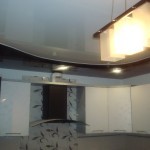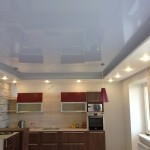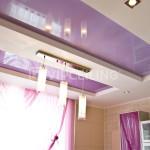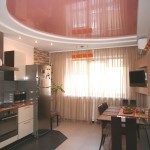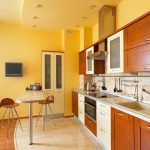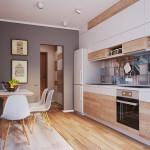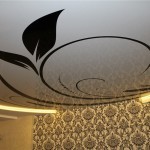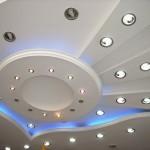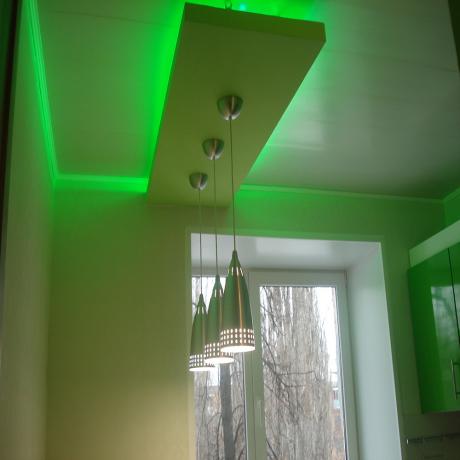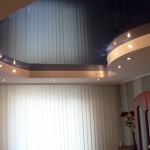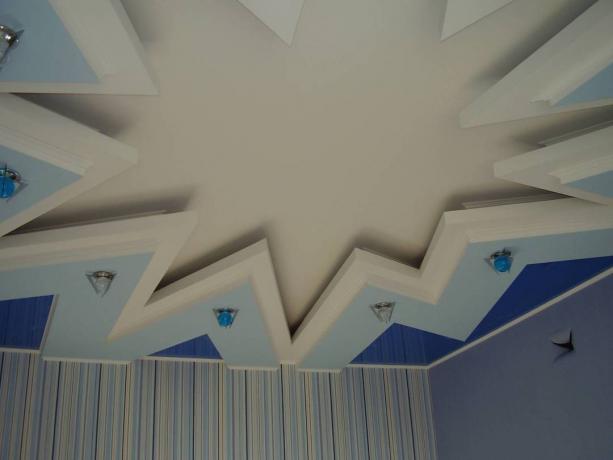Content
-
1 Types of ceiling structures
- 1.1 Plaster
-
2 Ceiling tiles
- 2.1 Plastic panels
- 2.2 Stretch ceiling
- 2.3 Plasterboard ceiling
- 3 Conclusion on the topic
More recently, there was practically no room for the ceiling in the concept of developing the design of a kitchen room. Most often it was simply whitewashed, at best (this applies to one's own houses) it was covered with plywood, creating an unpretentious design.
Everything changed overnight when various finishing materials poured into the domestic market. And the construction boom ended the whole thing, pushing our compatriots to a beautiful and comfortable life.
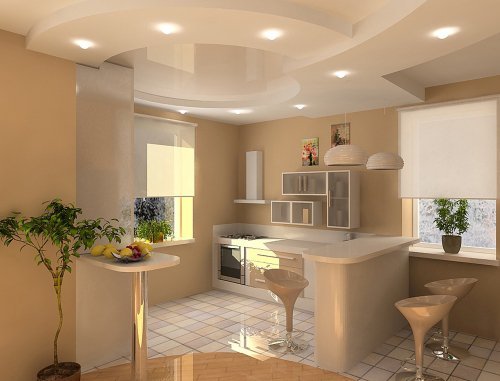
Original design - modern kitchen ceiling
So, in this article we will consider the design of ceilings in the kitchen. Consider the materials used in this process, installation and application technologies.
But, like any construction and repair process, the finishing of ceilings must begin with design.
That is, you need exactly:
- Choose the material with which it will be faced;
- Choose a color so that it is in harmony with other elements of the room, shape and design;
- In small kitchens, finishing should be carried out in such a way that the room becomes light and seemingly visually enlarged.
Types of ceiling structures
At this stage, it should be noted that designers are currently resorting to various options for formatting the ceiling.
Therefore, there are configurations that can be divided into the following types:
- Smooth ceiling;
- Vaulted;
- Multilevel;
- Figured.
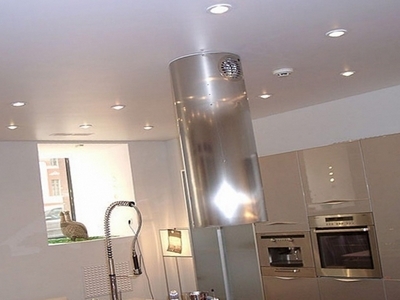
Smooth ceiling with lighting
To create the above variations, it is necessary to use some materials:
- Drywall;
- Plywood;
- Plastic panels;
- Plaster;
- Rack or cassette structures;
- Stretch ceiling;
- Ceiling tiles.
As you can see, the variety of shapes and materials is sufficient to speak of a large selection. Therefore, when starting a renovation, first of all, decide on the question of which ceiling design for the kitchen to choose. Therefore, there is a need to understand the basic options.
Duplex ceiling in the kitchen - see here.
Plaster
This method of finishing the ceiling surface can be classified as "old". It was used by both our grandfathers and our great-grandfathers.
Currently, many craftsmen are trying to move away from traditional technologies, which used a large number of additional elements and materials.
And with the appearance on the market of completely new and unique finishing solutions and compositions, it has also made it possible to change the very approach to this repair process.

Plastered ceiling
Increasingly, modern masters use putties for finishing the ceiling as the most effective material for leveling and strengthening it.
Therefore, there is a certain technology for their application. The design of the ceiling in the kitchen using plaster is mainly based on the selection of colors.
The point is that the plastered ceiling must be painted. And here again you will have to make a choice, because manufacturers offer a fairly wide range of paints and varnishes.
You can choose glossy paints, or you can choose structural ones (they create the texture of the surface and hide small defects in the plane). Well, the choice of color can be considered unlimited.
Here it is important to choose the right shade that would fit exactly into the overall design of the kitchen interior.
Advice! The selection of paint for the kitchen, especially for the ceiling, should be based on the fact that this particular room is wet, and negative factors act here that affect the quality of the ceiling surface.
Therefore, the paint, first of all, must meet the criteria of strength (wear resistance and moisture resistance) and practicality (it could be easily cleaned and washed with any liquid detergent).
Ceiling tiles
To talk about tiles for finishing the ceiling, it must be said that this type of cladding is not often used in the kitchen. It's a pity.
The thing is that this finishing material has a good appearance, the price is not high, and the installation is simple. In addition, currently on the market you can find ceiling tiles made of wood, expanded polystyrene, plastic.
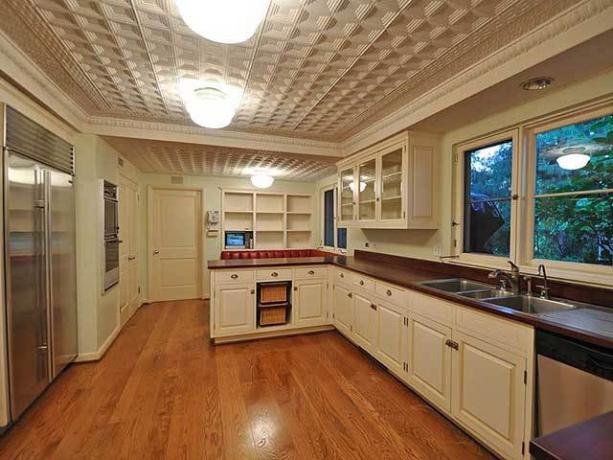
Ceiling tiles
It should be noted that the method of installing and fixing the plates to the ceiling is based on the use of adhesives.
And this suggests that the cladding with this material practically does not change the volume of space (the ceiling is reduced only by the thickness of the panels). How will humidity affect them?
There is no reason to worry about plastic and wood, but expanded polystyrene tiles have recently changed.
- At first, they began to cover it with a laminated layer, which allows it to withstand moisture.
- Secondly, the laminated layer makes it possible to diversify the color scheme plus imitate the surface of some natural materials, mainly wood.
Plastic panels
Kitchen ceiling design is based on three components:
- appearance;
- moisture resistance;
- practicality.
So, plastic panels meet all three requirements, add here the low cost of the material and ease of installation. Let's add such a moment that it makes no sense to prepare the base ceiling when using plastic panels. It is a suspended structure.
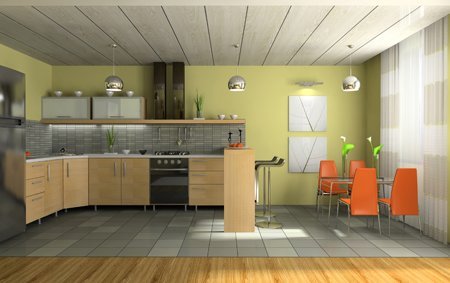
Plastic panels
First of all, you need to decide on the appearance. It must fit exactly into the overall interior design.
But with plastic panels it's not difficult. The variety is huge: from simple white panels to imitating wood, metal, stone and more.
And if you are still thinking about which finish to choose, we recommend plastic panels. In addition, spotlights can be installed in them, thereby creating original solutions that affect not only the design of the ceiling, but also the lighting of the space as a whole.
Stretch ceiling
This decorative ceiling covering has appeared quite recently, but immediately gained great popularity among both professionals and consumers. Stretch ceilings have more than enough advantages.
Let's note some of them.
- Very nice appearance.
- Practicality (you can wash it with any liquid household detergents).
- With a web thickness of 2 microns, it can withstand a load equal to one hundred liters of water per square meter of surface. So you are not afraid of flooding from the upper floors.
- The ability to diversify the design of stretch ceilings in the kitchen using photo printing.
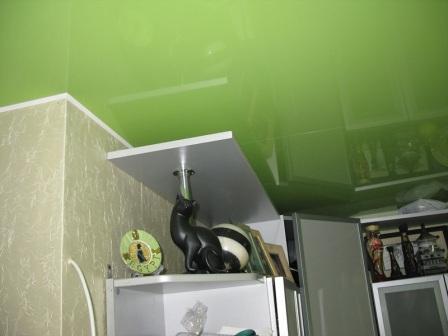
Stretch ceiling design in the kitchen is a great option, but expensive
And this is only a small fraction of the advantages of stretch ceilings. There are also disadvantages, but there are only two of them: the canvas is afraid of sharp and cutting objects and the cost of the material is not yet available to everyone.
Advice! Anyone who wants to install a stretch ceiling in the kitchen with his own hands, we recommend not even trying to do it. The thing is that, despite its apparent simplicity, this is a rather complex process that requires special equipment, skills to work with it, as well as knowledge that ordinary people do not own.
Therefore, shift the burden of responsibility onto the shoulders of specialists. In addition, the installation of the stretch fabric in the kitchen will take them no more than two hours. The room is small.
Read also an article about the original design of the P 44T kitchen with a bay window.
Plasterboard ceiling
Plasterboard ceilings are today one of the most demanded options for finishing the ceiling surface. And the kitchen is no exception.
But it should be noted that the design of the plasterboard kitchen ceiling has some nuances that depend on the dimensions of the room itself.
Let's give two examples that will accurately determine the priorities, but before that, we note that the plasterboard ceiling is a suspended structure.
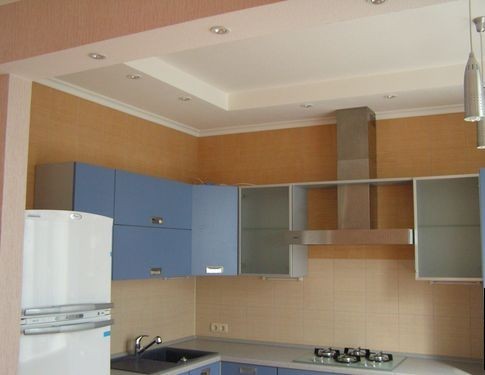
Multilevel plasterboard ceiling
- In a small kitchen, it makes no sense to install multi-tiered structures (photo above) and various plasterboard curly elements. They will hang over a small area, so it will be impossible to achieve comfort. But, if a redevelopment was carried out, that is, combined into one space, say, a kitchen and a living room, then, for example, a two-level ceiling in the kitchen would be an ideal option. With its help, you can create the zoning of the combined space.
- If the kitchen has a large overall dimensions (this mainly applies to private houses), then you can play with drywall at your discretion. There is no point in limiting your imagination here. Do not be afraid to experiment, try to approach the design of the ceiling from different positions.
The only thing that will have to be considered in the category "kitchen plasterboard ceiling design" is the color scheme. You can paint such a ceiling, cover it with ceiling tiles, glue wallpaper on it. All in your hands.
Advice! For finishing the ceiling in the kitchen, it is best to use moisture-resistant drywall. Its surface is greenish.
Conclusion on the topic
I would like to give one piece of advice. It doesn't matter which finish you choose for the kitchen ceiling (a lot will depend on the budget for the renovation).
Here it is important, as mentioned above, to create harmony of the ceiling surface with other design elements, to choose finishing material so that it meets the requirements of wet rooms and does not create problems for the hostess when service.

Unusual ceiling
And if the walls are not as high as you would like, then you will have to postpone the design of suspended ceilings in the kitchen. But this is also at your discretion. Let this article be your guide.
Kitchen design with a bay window - see here.




